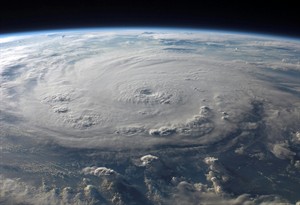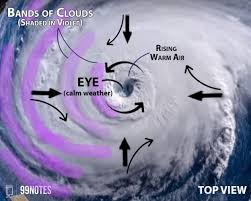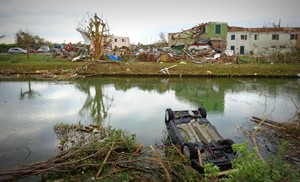In December, Eva was in Chennai when a cyclone from the Bay of Bengal struck. Heavy rain and strong winds flooded the streets, power went out, and people rushed to safety. Boats rescued families, and relief workers provided food and water.
After experiencing the heavy rain, strong winds, and floods in Chennai, Eva wondered: “What exactly is a cyclone and how does it form?”
What is a Cyclone?
A cyclone is a large spinning storm of clouds, strong winds, and heavy rain. It develops over warm ocean waters around a centre of very low pressure, called the eye of the cyclone.

Cyclone
How cyclones form?
-
When the sun heats ocean water, some of it evaporates, turning into water vapour.
-
This warm, moist air rises upward because it is lighter.
-
As the air rises higher, the water vapour condenses into raindrops, releasing heat back into the atmosphere.
-
This released heat makes the air even warmer, so it rises further, creating a low pressure area.
-
Surrounding air rushes in to fill this low pressure, and it also rises.
-
The Earth’s rotation makes these winds start spinning around the low pressure centre.
-
This cycle repeats again and again, building up into a powerful spinning storm called a cyclone.
Eye of the cyclone:
The centre of a cyclone is called the eye. The eye has the lowest pressure but calm weather. Around the eye, there are very strong winds and heavy rain.

Eye of the cyclone
Strength of cyclones:

-
Cyclones are much stronger than normal thunderstorms.
-
As long as they are over the sea, they stay strong because they get moist air.
-
Once they move onto land, they lose strength since the source of moist air is cut off.
-
Even after weakening, they can still cause great damage.
-
Strong winds can reach speeds of more than \(200\) \(km/h\).
-
Winds push ocean water towards the coast, creating a storm surge (a wall of water \(3\)–\(12\) \(m\) high).
-
Storm surges flood coastal areas, sometimes even far inland.
-
Heavy rainfall can cause rivers to overflow and trigger landslides.
-
Seawater entering fields can damage crops and make soil salty, reducing fertility.
-
Drinking water sources may get contaminated.
-
Roads can be blocked by fallen trees and debris.
-
Power and communication lines may be damaged, disrupting daily life.

Destruction caused by a cyclone
Example:
Cyclone Amphan (\(2020\)) had peak winds of \(270\) \(km/h\), causing massive destruction.
Protection from cyclones:
-
Stay updated with weather reports and warning issued by the India Meteorological Department (IMD).
-
Use information from satellites to track cyclone paths.
-
Keep an emergency kit ready if you live in a cyclone-prone area.
-
During a cyclone, move to a designated cyclone shelter.
-
National and international organisations work together to reduce cyclone damage.
Names of cyclones:
Cyclones have different names in different parts of the world. In the Indian ocean (Bay of Bengal and Arabian Sea), they are called cyclones. In the Atlantic ocean and Eastern Pacific ocean (near the USA and Caribbean), they are called hurricanes. In the Western Pacific ocean (near Japan, Philippines, and China), they are called typhoons. In Australia, they are called willy-willies.
Reference:
https://insides.home.blog/wp-content/uploads/2019/05/screenshot-15.png